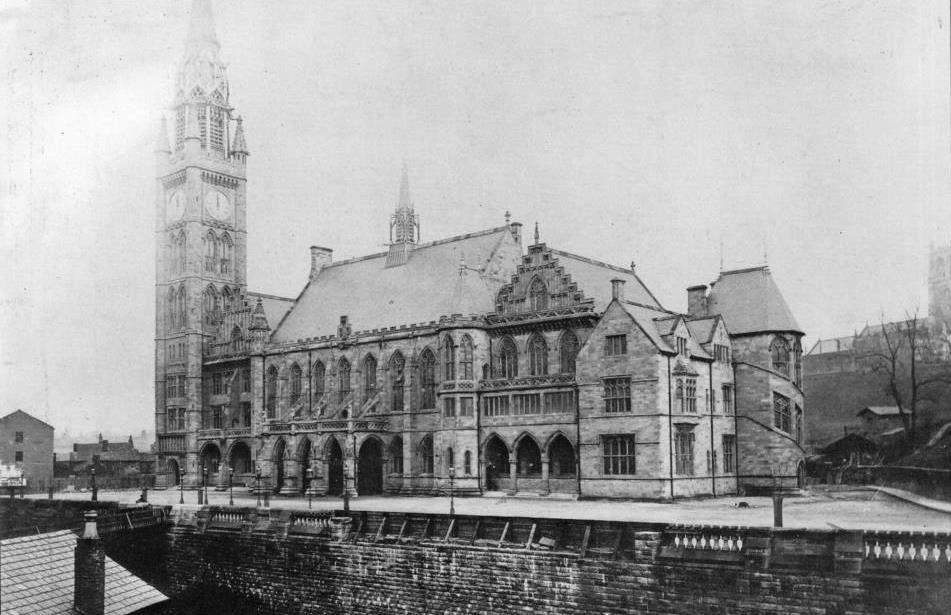The Old Town Hall Tower

Due to the extraordinary increase in industrial wealth of the town in the 18th and 19th century it was felt that Rochdale should have a formal town hall to recognise the fact. Before the middle of the 19th century the town had used a number of buildings for its civic activities, a study by Maxim in 1959 suggesting that council business had been held on Blackwater Street and at a Law Commissioner office on Smith Street. With the town’s Charter of Incorporation in 1856 Rochdale became a municipal borough and pressure was on for a proper town hall, one proposal coming forward in 1858 to house the Gas Company in it with gas profits going towards its building. A number of sites were suggested amongst them Town Head House, Butts House, Wet Rake, the house of a Mr Kelsall on Smith Street where the Wellington now stands, The Orchard (being the Byron family manor where Newgate is now) and an area called The Wood. The latter was voted for and the Woods Estate was purchased from the Vicar of Rochdale for the site for £4730.

Originally the Town Hall was intended to house an Exchange, the entrance hall long being known by that name as well as a Free Library, Art School, Fire Station and a residence for a Police constable, which didn’t happen. For guidance in 1863 a committee from Rochdale visited Halifax, Leeds and Preston looking at the costs of such buildings and then undercut them all with a proposed budget of £20,000. The eventual cost rose to £154,755 although Councillor George Leach Ashworth thought it worth it, writing ‘we cannot have beauty without paying for it.’ And certainly, Rochdale Town Hall, designed by W H Crossland was to be a magnificent example of the medieval gothic based on the style of Belgian cloth halls. The Lord Mayor alongside Councillor Ashworth was there in 1871 to perform the opening ceremony five years after John Bright had laid the first cornerstone.

But the town hall tower we see today was not the original one. The first tower, much taller, was a painted and gilded spire with a wooden frame of 240 ft on top of which stood a ring of trumpeting angels below a symbolic 12ft statue of St George and the Dragon which, including its lead covering, weighed 30 cwt (or 1500 Kilograms). At one point when the statue was in need of repair Joseph Smith (Rochdale’s version of Fred Dibner) climbed to the top up the lightning conductor fastened to St George in order to carry it out. In the original tower was a carillon of 12 bells which not only chimed the hours and quarters but also played 14 tunes including Rule Britannia, Auld Lang Syne, Yankee Doodle and Home Sweet Home. The old clock itself had a dial of 12ft in diameter, the weights to drive the clock being 1 ton each and having to be hoisted through 70ft against gravity. Evidently a Mr Deakin, living in Granville Square, used to wind the weights up every Sunday.

Nine years after opening the building, in 1882, dry rot was spotted in the wooden structure of the spire and the borough Surveyor Mr Platt recommended demolition as far down as the stone battlements. The council agreed and work was started. However, at 9.30pm on April 10th 1883, whether caused by a gas leak as was suggested or whether it was arson, during a concert at the Public Hall (not the Town Hall) by Rochdale Choral Society singing ‘Elijah,’ fire broke out in the tower. Acting like a chimney with a fierce flue, the clock tower which housed many library items went up like a torch although some brave council workers went into the fire to rescue some of the books.

Not only was the Free Library destroyed but so were the Town Clerk’s chambers. The fire was huge and could be seen as far away as Blackstone Edge. Fortunately, no-one died although two police constables inside the library were badly burned. A large crowd gathered on the Esplanade to watch the blaze and cheered as the steam engines and pumps from Milnrow and Oldham arrived. A telegram to the Heywood fire crew found their telegraph office closed so they didn’t arrive until next morning. At about 10.40pm to the cries of on-lookers, the figure of St George and the Dragon fell to earth. Early next day some people took souvenirs from the pavement of the statue’s wood carving and gold leaf and metal from the old bells that had melted and crashed to the ground. Insurance covered part-cost of the disaster of £17,800 although the overall damage was £20,000.

The replacement tower, completed in 1887 and designed by the architect A Waterhouse who also designed Manchester Town Hall, is 49 feet shorter than the original one but holds additional weight of bells. It is felt by many to be in better proportion to the rest of the building, some considering that the old tower made it look more like a cathedral than a town hall. A great deal of the stonework from the old tower was buried but some say that masonry was salvaged and used in the garden walls of cottages near the Elephant and Castle on Bury Road, a case of early but heavy re-cycling !